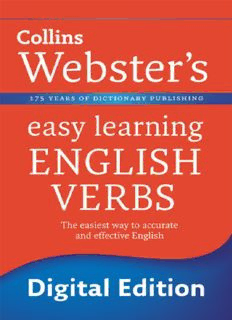
English Verbs PDF
Preview English Verbs
HarperCollins Publishers Westerhill Road Bishopbriggs Glasgow G64 2QT First edition 2011 Reprint 10 9 8 7 6 5 4 3 2 1 0 © HarperCollins Publishers 2011 EPUB Edition © November 2011 ISBN 978-0-00746196-7 Collins ® is a registered trademark of HarperCollins Publishers Limited www.collinslanguage.com A catalogue record for this book is available from the British Library Printed in Great Britain by Clays Ltd, St Ives plc All rights reserved under International and Pan-American Copyright Conventions. By payment of the required fees, you have been granted the non- exclusive, non-transferable right to access and read the text of this e-book on screen. No part of this text may be reproduced, transmitted, downloaded, decompiled, reverse engineered, or stored in or introduced into any information storage and retrieval system, in any form or by any means, whether electronic or mechanical, now known or hereinafter invented, without the express written permission of HarperCollins. Entered words that we have reason to believe constitute trademarks have been designated as such. However, neither the presence nor absence of such designation should be regarded as affecting the legal status of any trademark. HarperCollins does not warrant that www.collinsdictionary.com, www.collinslanguage.com or any other website mentioned in this title will be provided uninterrupted, that any website will be error free, that defects will be corrected, or that the website or the server that makes it available are free of viruses or bugs. For full terms and conditions please refer to the site terms provided on the website. Editorial staff American English consultant: Orin Hargraves Senior editors: Penny Hands Kate Woodford Project management: Lisa Sutherland Contributors: Sandra Anderson Jennifer Baird Katharine Coates For the publisher: Lucy Cooper Kerry Ferguson Elaine Higgleton Computing support: Thomas Callan contents Introduction Guide to entries Pronunciation guide What is a verb? The verb phrase Direct and indirect objects Transitivity Types of verb Reflexive verbs Reciprocal verbs Linking verbs Irregular verbs Auxiliary verbs Modal verbs Phrasal verbs Tense Introduction to tense Types of main verb The forms of main verbs Tense Aspect Continuous and perfect forms The present simple tense The present continuous The present perfect The present perfect continuous The past simple tense The past continuous The past perfect The past perfect continuous Future reference Voice Active and passive Infinitives and the -ing form The infinitive The to infinitive The to infinitive and the -ing form Word order Verbs and affirmative, negative, interrogative, and imperative statements Word order in affirmative statements Word order in negative statements The interrogative WH-words Sentence tags The imperative The subjunctive Clauses Verbs and conditional clauses Verbs and reporting speech Reported speech A–Z of important verbs Key Verbs be be able to be going to be meant to be supposed to can and could dare and need do have have got to have to may and might must ought to shall and will should used to would would rather Irregular verbs Index introduction Collins Webster’s Easy Learning English Verbs is designed for anyone who wants to improve their knowledge of English verbs and the way they work. Whether you are preparing for exams, need a quick look-up guide to English verbs, or you simply want to browse, Collins Webster’s Easy Learning English Verbs offers you the information you require in a clear and accessible format. A verb is a word that tells us about an action, an activity, a process, a state of being, or a state of mind. All grammatically complete sentences in English contain at least one verb. The form of a verb helps us to express some important ideas: the time the action is taking place, who carries it out, how likely it is that it will happen, how many people perform the action, and so on. The first section of the book, called “What is a verb?”, tells you more about tenses, the different grammatical forms of the verb, and how verbs work in a sentence. The second section of the book contains dictionary entries of the most important types of verb. Most verbs in English are main verbs; these express actions and states. A special type of verb, called an auxiliary verb, is used in combination with a main verb to express ideas such as time, certainty, doubt, and completion. Some examples of auxiliary verbs are be, do, have, can, could, and will. Auxiliary verbs are explained in detail in the “key entries” in the dictionary section. Phrasal verbs are also an important feature of English. English speakers use phrasal verbs in all contexts – not just in informal situations. The most common phrasal verbs are listed at the end of the entry for the verb they are related to. For example, the phrasal verbs hang on and hang up are listed under the entry for hang. Some of the most useful English verbs are irregular. Irregular verbs are verbs that do not form the past simple tense and the past participle in the regular way. The most important irregular verbs are marked with a star in the dictionary section. There is also a list of the most common irregular verbs and their inflections on pages 246–247. All explanations throughout the book are fully illustrated with examples of natural English taken from the Collins 4-billion-word corpus. We hope you enjoy finding out more about this important area of the English language. For more information about Collins dictionaries, visit us at www.collinslanguage.com. guide to entries
Description: